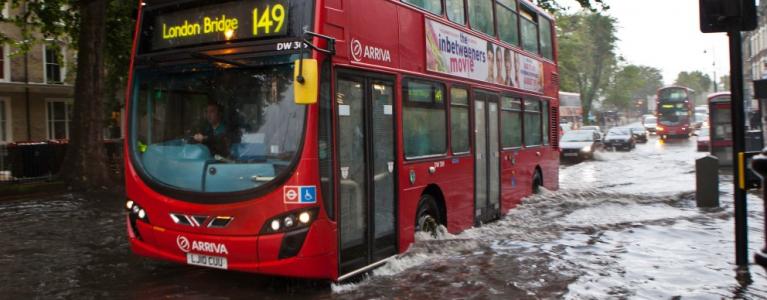
It has been an unprecedented and challenging year for Londoners. Staying safe and looking out for friends and family during the pandemic is rightly everyone’s priority at this difficult time.
For the last three years, we have hosted London Flood Awareness Week a campaign to make Londoners aware of flood risk in the capital and what they can do to be prepared and stay safe if they are affected by flooding. As we move into autumn and winter, we will experience more frequent wet weather events. Sadly, this means that you or your friends or neighbours may be affected.
We are running London Flood Awareness Week at the same time as the Environment Agency’s national Flood Action Week.
Did you know that 1.3 million people live and work in areas of the city at risk of tidal and river flooding? How about that around a third of London’s basement properties are at risk of flooding in a severe storm? These are big numbers, and the problem would be even worse without London’s extensive flood defence system, including the iconic Thames Barrier.
Flooding from heavy rainfall and burst water pipes can be unpredictable. The climate emergency means there will be more regular and intense periods of rainfall which will increase the likelihood of flood events. Unfortunately, these can happen anywhere, at any time. And they can have disproportionate effects on people who are least able to cope with flooding (for example, older Londoners and those with poor physical or mental health).
Whether it’s losing precious photographs, or having to replace furniture or important documents, flood damage can cost people a lot of money and take a long time to recover from. The average cost of flooding to a home is £30,000 and £82,000 to a business, so it pays to be aware and prepared. There are lots of quick and simple things you can do now to help prepare for flooding. Taking just one action can the reduce the impacts on your home and family.
Actions that everyone can take:
- check your risk of flooding from heavy rainfall (also known as surface water flooding), rivers and the tidal Thames by typing your address into the Environment Agency’s flood risk checker
- sign up for severe weather alerts from the Met Office
- sign up for flood warnings from the Environment Agency
- support family, friends and neighbours in a safe way, for example by checking their flood risk or signing up for severe weather alerts and flood warnings on their behalf
- Familiarise yourself with the Government’s advice on what to do in a flood
Actions to take if you are at a high risk of flooding and / or you receive a severe weather alert or flood warning
Examples of actions you can take include:
- having your medicine and insurance documents to hand
- putting your precious and important belongings somewhere safe, like a high shelf or in a waterproof container
- moving family, pets and car to safety
The Government’s what to do in a flood web page provides some more helpful advice
In rare cases, it may be necessary to leave your home and move to a community refuge – during England’s latest lockdown you can leave your home if you are at risk of injury or harm – for more information visit our coronavirus hub. Please follow the latest Covid-19 guidance and the advice of emergency services before leaving your home.
Your local council may have more instructions on what to do and where to go in an emergency. You can find your Council here.
What is the Mayor doing to help?
To help improve the ability of London and Londoners to deal with flooding, the Mayor is:
- committing to a green recovery from the coronavirus pandemic, ensuring London’s response tackles the climate and ecological emergencies.
- strengthening policies in the London Plan to reduce the risk of flooding and increase the resilience of new developments to flooding
- delivering the London Sustainable Drainage Action Plan to help reduce the risk of surface water flooding across the city
- developing sector specific guidance on sustainable drainage covering schools, social housing and parks and green spaces
- funding local projects to support climate change adaptation and reduce flood risk through his Greener City Fund and Grow Back Greener fund
- supporting Integrated Water Management Strategies across the city to ensure new developments consider the effects of flooding, sewer capacity and water scarcity
- helping Londoners to make the city greener, healthier and wilder, which will also help manage surface water flood risk
- working with Thames Water to reduce the risk and impact of burst water mains
- supporting the Thames Estuary 2100 Plan to protect London from future tidal flooding, for example as a result of rising sea levels
You can also do your bit to help reduce the risk of flooding, encourage wildlife and support your wellbeing by changing just a part of your garden from grey to green. You can start small, even if you don’t have a garden of your own.
To find out more about how to prepare for flooding, check out our webpage.